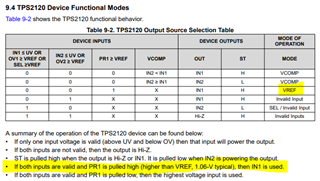Other Parts Discussed in Thread: TPS2121
We are using TPS2120 power Mux with (YFP) Package 20-Pin WCSP in the circuit boards, currently our circuits are designed to work in "Highest Voltage Operation (VCOMP)" as in the datasheet, connecting pins PR1 & SEL to Ground. limiting the ILM to 1.5A.
Among the fabricated & assembled 7 no's of boards only 3 no's of boards are working perfectly as per the datasheet when both inputs are varied & tested. other 4 no's of non working boards have major issues while tested. in one board status ST showing high, even when both inputs are ON with same voltage of 12V. in other 2 no's of boards input 1 is not working, only when source is given at input 2, output is working as per the input. but when source is given from input1 disconnecting input 2, output is zero. in the 4th board both inputs are not working when we source the supply from inputs 1 & 2, output is Zero.
Input voltage at what we are sourcing & testing the device is at 12V.
kindly let us know what may be the issue? is that may be of manufacture or assembling issue in the IC. as its BGA kind of IC, its difficult to check the behavior at particular pins. also we have considered the layout guidelines as per in the datasheet.
kindly suggest us to resolve this issue or let me know the alternate way to solve the problem at earliest.






